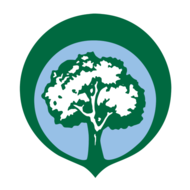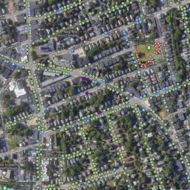Urban Forest Plan
This plan is a manual for how the Boston community can work together to prioritize, preserve, and grow our tree canopy.
Read the full plan
GOALS
goalsThe goals in this plan emerged through a community-led process. The City sought to answer the questions “What does success look like?” and “What will Boston look like or be like that day when we can say ‘we did it’?”
The community determined that success comes
- when equity guides action,
- when trees are proactively cared for and protected,
- when the community is involved in the decisions made for their neighborhood,
- and when trees are prioritized and valued for their true and full role in the services provided to Boston’s residents.
A number of efforts, programs, policies and resources will be a part of the implementation of this plan. As Boston builds processes, seeks funding, and launches efforts, the time, resources, and priorities that will go into this work must be distributed equitably and begin to address historic exclusion and current social vulnerability.
Growing a healthy urban forest takes time; it must be planted and cared for on a long-term basis. Proactive care will improve the chances that trees in Boston reach maturity. It is critical that trees reach the stage of life that is most beneficial to the community (e.g. removal of air pollution, cooling the city, etc.).
Residents have asked for ways to easily provide input into decisions that impact their community, and ensure that their needs, goals, and aspirations are integrated into and prioritized in decisions made. This requires better communication, collaboration, and transparency between all members of the Boston community. This includes City officials, residents, leaders of advocacy groups, and more.
The urban forest must be a priority and focus for the entire community, both public and private. Decision-making across all efforts in Boston must factor in the urban forest. Improving the urban forest isn't an either/or trade-off. Rather, we need to find ways to create opportunities to integrate trees in a mutually supportive way into other priorities.
POWER OF TREES AND TREE CANOPY
- provide intergenerational ties to nature and neighborhoods
- play an important role in cultural and spiritual practices
- improve mental health
- provide essential wildlife habitat
- reduce heat and adverse health impacts of extreme heat
- reduce flooding due to excess rainfall (stormwater)
- can improve water quality
- help reduce air pollution
- help communities save money via reduced energy costs
- can help lower carbon levels in the atmosphere to some extent, and promote walkable, bikeable communities
explore the data
Community Advisory Board notes
canopy change assessment
public STRET tree and PARK TREE inventory
- Download live data: Public street tree and park tree data is available for download on Analyze Boston. Updated as new information becomes available.
- Interact with live data: Interactive map available on Caring for Boston's Urban Forest web page.
- View a 2021 snapshot: look at the top 10 street tree species in your neighborhood (accurate as of May 2021)
SEVEN KEY STRATEGIES
strategiesProgressive and proactive urban forestry work requires coordination, resources, and organizational restructuring. Recommendations to support this strategy include:
- establish an urban forest leadership position within the City,
- increase operational staffing resources for public tree management,
- improve systems for collaboration and review with community partners, and
- institute a community tree board and a network for institutional coordination.
Existing trees need care and maintenance to grow Boston's tree canopy. Recommendations to support this strategy include:
- develop a proactive work plan for trees on public land,
- institute a recurring maintenance program for trees on public land,
- perform plant health care and integrated pest management,
- prioritizing proactive tree care in areas of highest need,
- better management and protection of trees with clear policies,
- increase interdepartmental support on urban forestry efforts, and
- put in place policies to protect and enhance the urban forest.
This strategy focuses on adding more trees by prioritizing equity and public health. Recommendations to support this strategy include:
- set up a process for neighborhood planting strategy work,
- identify and plant in priority areas,
- expand canopy with future resilience in mind, and
- expand canopy through street tree planting in priority areas, in open spaces in priority areas, and
- expand canopy near sites/sources of pollution, on residential land in priority areas, and around quality of life factors.
Urban spaces like Boston have limited quality planting spaces for trees. Recommendations to support this strategy include:
- (re)design streets to create space for trees,
- balance parking and room for planting,
- seek changes to building design and lot coverage to make space for trees,
- reestablish a setback planting program,
- explore adding tree canopy to underutilized/vacant lands,
- put in place new planting standards,
- minimize above-grade and below-grade conflicts, and
- improve soil quantity and quality.
Communication, transparency, and collaboration are critical for proper tree care. With improvements, we will address past inequitable practices, and provide effective constituent services. Recommendations to support this strategy include:
- increase city urban forestry staffing devoted to communication and outreach,
- improve avenues of City communications, and
- promote awareness of the role of trees in Boston.
Trees are like any other critical infrastructure. That requires knowledge and information to make decisions on proactive care and management. Recommendations to support this strategy include:
- complete the public tree data set,
- ensure resources available for data upkeep,
- perform detailed analysis on sources of tree canopy losses,
- plan and budget for the next Urban Tree Canopy assessment update,
- explore tree data collection across private land, and
- make tree data more accessible to all residents.
There is a shortage in labor in the urban forest industry - both nationwide and in Boston. This gap is an opportunity to train and hire Boston residents for tree care-related work. Recommendations to support this strategy include:
- support existing workforce development opportunities,
- establish a career pathway program, and
- create and support forest-related economic development opportunities.
NEIGHBORHOOD STRATEGIES
Neighborhood strategieshow can i get involved?
- A major way to help the forest is to be kind to existing trees, particularly their bark and soil.
- Keep dogs away from trees. Their urine is extremely harmful to tree bark and can contribute to a tree's death. Young trees, like newly planted street trees, are particularly susceptible to dog urine.
- Refrain from locking bikes to trees. Locks can open wounds in the tree and expose it to harmful pathogens.
- Avoid stepping in tree pits or piling trash in pits. Soil compaction suffocates tree roots by depriving them of water and the air they get from the water. It will also become difficult for roots to grow through increasingly hard soil.
- Driving a larger vehicle such as a delivery truck or construction vehicle? Take care to avoid sideswiping and backing up into trees and be aware of your height clearance to avoid touching trees.
- Reach out to a local community group or tenant's association to see how you might support their tree advocacy, tree stewardship programming, or learn about existing workforce development programs.
- Submit a 311 case to request public tree maintenance or a street tree planting.
- Consider planting a tree on your property or speaking with your landlord about getting a tree planted.
- Visit Caring for Boston's Urban Forest for more information on how to help care for trees.
- Explore PowerCorpsBOS to see if you qualify for this young adult green jobs training program.
- Visit the Career Center for employment opportunities with the City.
- Stay tuned! As the urban forestry program grows, there will be more opportunities to engage with trees.
Latest news
Latest newsRelated projects
Open Space and Recreation Plan
Updating the seven-year plan
A citywide discussion on the many ways in which open space and recreation in Boston can be more responsive to community needs.
Heat Resilience Solutions for Boston
Preparing for extreme heat
This plan provides a citywide framework to prepare Boston for hotter summers, with particular focus on Boston's environmental justice neighborhoods.
Healthy Places
Planning for heat, trees, and open space
A coordinated planning effort to cool the city, expand the urban forest, and improve the park system.





